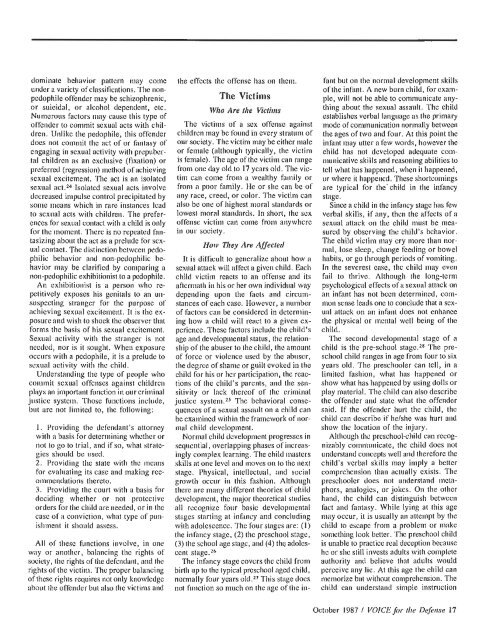OCTOBER D87 - Voice For The Defense Online
OCTOBER D87 - Voice For The Defense Online
OCTOBER D87 - Voice For The Defense Online
You also want an ePaper? Increase the reach of your titles
YUMPU automatically turns print PDFs into web optimized ePapers that Google loves.
dominate behavior pattern may comeunder a variety of classifications. <strong>The</strong> nonpedophileoffender may be schizophrenic,or suicidal, or alcohol dependent, etc.Numerous factors may cause this type ofoffender to commit sexual acts with children.Unlike the pedophile, this offenderdoes not commit the act of or fantasy ofengaging in sexual activity with prepubertalchildren as an exclusive (fixation) orpreferred (regression) method of achievingsexual excitement. <strong>The</strong> act is an isolatedsexual act.z4 Isolated sexual acts involvedecreased impulse control precipitated bysome means which in rare instances leadto sexual acts with children. <strong>The</strong> preferencesfor sexual contact with a child is onlyfor the moment. <strong>The</strong>re is no repeated fantasizingabout the act as a prelude for sexualcontact. <strong>The</strong> distinction between pedophilicbehavior and non-pedophilic behaviormay be clarified by comparing anon-pedophilic exhibitionist to a pedophile.An exhibitionist is a person who repetitivelyexposes his genitals to an unsuspectingstranger for the purpose ofachieving sexual excitement. It is the exposureand wish to shock the observer thatforms the basis of his sexual excitement.Sexual activity with the stranger is notneeded, nor is it sought. When exposureoccurs with a pedophile, it is a prelude tosexual activity with the child.Understanding the type of people whocommit sexual offenses against childrenplays an important function in our criminaljustice system. Those functions include,but are not limited to, the following:1. Providing the defendant's attorneywith a basis for determining whether ornot to go to trial, and if so, what strategiesshould be used.2. Providing the state with the meansfor evaluating its case and making recommendationsthereto.3. Providing the court with a basis fordeciding whether or not protectiveorders for the child are needed, or in thecase of a conviction, what type of punishmentit should assess.All of these functions involve, in oneway or another, balancing the rights ofsociety, the rights of the defendant, and therights of the victim. <strong>The</strong> proper balancingof these rights requires not only knowledgeabout the offender but also the victims andthe effects the offense has on them.<strong>The</strong> VictimsWho Are the Victims<strong>The</strong> victims of a sex offense againstchildren may be found in every stratum ofour society. <strong>The</strong> victim may be either maleor female (although typically, the victimis female). <strong>The</strong> age of the victim can rangefrom one day old to 17 years old. <strong>The</strong> victimcan come from a wealthy family orfrom a poor family. He or she can be ofany race, creed, or color. <strong>The</strong> victim canalso be one of highest moral standards orlowest moral standards. In short, the sexoffense victim can come from anywherein our society.How ney Are AffecfedIt is difficult to generalize about how asexual attack will affect a given child. Eachchild victim reacts to an offense and itsaftermath in his or her own individual waydepending upon the facts and circumstancesof each case. However, a numberof factors can be considered in determininghow a child will react to a given experience.<strong>The</strong>se factors include the child'sage and developmental status, the relationshipof the abuser to the child, the amountof force or violence used by the abuser,the degree of shame or guilt evoked in thechild for his or her participation, the reactionsof the child's parents, and the sensitivityor lack thereof of the criminaljustice system.25 <strong>The</strong> behavioral consequencesof a sexual assault on a child canbe examined within the framework of normalchild development.Normal child development progresses insequential, overlapping phases of increasinglycomplex learning. <strong>The</strong> child mastersskills at one level and moves on to the nextstage. Physical, intellectual, and socialgrowth occur in this fashion. Althoughthere are many different theories of childdevelopnlent, the major theoretical studiesall recognize four basic developmentalstages starting at infancy and concludingwith adolescence. <strong>The</strong> four stages are: (1)the infancy stage, (2) the preschool stage,(3) the school age stage, and (4) the adolescentstage.26<strong>The</strong> infancy stage covers the child frombirth up to the typical preschool aged child,normally four years This stage doesnot function so much on the age of the in-fant but on the normal development skillsofthe infant. A new bornchild, for example,will not be able to communicate anythingabout the sexual assault. <strong>The</strong> childestablishes verbal language as the primarymode of communication normally betweenthe ages of two and four. At this point theinfant may utter afew words, however thechild has not developed adequate communicativesk~lls and reasoning abilities totell what has happened, when it happened,or where it happened. <strong>The</strong>se shortcomingsare typical for the'child in the infancystage.Since a child in the infancy stage has fewverbal skills, if any, then the affects of asexual attack on the cbild must be measuredby observing the child's behavior.<strong>The</strong> child victim may cry more than normal,lose sleep, change feeding or bowelhabits, or go through periods of vomiting.In the severest case, the child may evenfail to thrive. Although the long-termpsychological effects of a sexual attack onan infant has not been determined, commonsense leads one to conclude that a sexualattack on an infant does not enhancethe physical or mental well being of thechild.<strong>The</strong> second developmental stage of achild is the pre-school stage.28 <strong>The</strong> preschoolchild ranges in age from four to sixyears old. <strong>The</strong> preschooler can tell, in alimited fashion, what has happened orshow what has happened by using dolls orplay material. <strong>The</strong> child can also describethe offender and state what the offendersaid. If the offender hurt the child, thechild can describe if helshe was hurt andshow the location of the injury.Although the preschool-child can recognizablycommunicate, the child does notunderstand concepts well and therefore thechild's verbal skills may imply a bettercomprehension than actually exists. <strong>The</strong>preschooler does not understand metaphors,analogies, or jokes. On the otherhand, the cbild can distinguish betweenfact and fantasy. While lying at this agemay occur, it is usually an attempt by thechild to escape from a problem or makesomething look better. <strong>The</strong> preschool childis unable to practice real deception becausehe or she still Invests adults with completeauthority and believe that adults wouldperceive any lie. At this age the child canmemorize but without comprehension. <strong>The</strong>child can understand simple instructionOctober 1987 / VOICE for the <strong>Defense</strong> 17
















